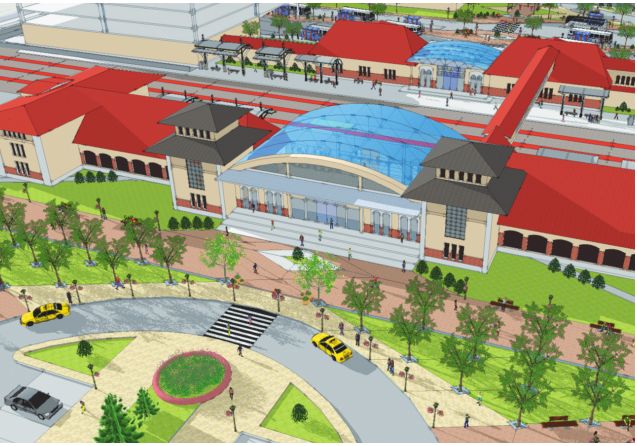Will a transit center take Springfield where it wants to go?
DYSPEPSIANA | James Krohe Jr.

I suppose the question to
the Springfield City Council ought to be phrased this way: If they come,
will you build it? “It” is a multimodal transit center, a nice plan for
which was unveiled in February by Downtown Springfield, Inc. and the
Springfield-Sangamon County Regional Planning Commission [See the Feb.
23 IT cover story, “Trains, buses and stores: A 10th Street
transportation center could bring Springfield together,” by Neil
Schneider.] It’s a concept drawing, not a blueprint, but if built the
center would occupy the half-block between 9th and the 10th Street
tracks and Washington and Jefferson streets – if, that is, passenger
trains eventually trundle up and down the 10th Street tracks rather than
along Third Street.
Springfield’s transit
center would be a central interchange point where buses serving city,
charter and intercity routes, airport, downtown and tourist shuttles,
taxis and rental cars, bicycles and, of course, Amtrak passenger trains
would meet and mingle, thus linking the many parts of the city’s
transport system into a more efficient whole.
Makes
sense. Make public transit more convenient and you make it more
popular. What is widely reckoned to have been Illinois’ first gen uine
transit center outside Chicago is in downtown Champaign, at the downtown
Illinois Terminal, which opened in 1999. There travelers arriving by
city bus or taxi can board Amtrak trains to Chicago, St. Louis or
Indianapolis as well as intercity buses, including the massively popular
Megabus. Two to three thousand travelers are said to pass every weekday
through Illinois Terminal.
Does
that sort of future await Springfield? A multimodal transit center will
be used only to the extent there is demand for intermodal trips.
University towns like Bloomington-Normal (which is building its own
transit center) and Champaign-Urbana have large populations of students
who are relatively poor, who make several trips out of town every year
and who do not own their own cars. It is no accident that the number of
people passing through Illinois Terminal is often higher on weekends
than during the work week, which is the reverse of the usual pattern.
Nor
is it an accident that travelers in C-U can connect to a more evolved
city bus system than Springfield’s, one that offers Sunday service and
five of whose lines run later than 3 a.m. during the academic year. In
contrast, UIS students are fewer, SMTD
offers no connecting service to campus on Sundays when most return from
trips, and only hourly service other days. Car ownership among students
is high, thanks to university policies that encourage it, such as free
parking and a campus conveniently and stupidly located just off the
interstate.
Editor’s note
Nobody
doubts that $8 million in budget cutbacks at Springfield public schools
will hurt the quality of education offered here. The dire fiscal news
follows our reporting last week that student test scores in District 186
are already dismal and not improving. As the city schools deteriorate,
those who can are continuing to move to the bedroom communities of
Chatham, Sherman, Rochester, Riverton and other towns, where schools are
growing and some are thriving. The flight to the edges is damaging the
core, and thousands of children are being left behind. –Fletcher Farrar,
editor
Larger
hopes than increasing transit use ride on the transportation center. It
is assumed to have happy effects on tourism and downtown development.
The first is a topic that must await a future column. As for
development, increasing transit access does indeed tend to push up the
value of adjacent properties. That’s why property owners along new
streetcar lines in Portland, Ore., not only agreed to but were eager to
pay a special assessment that largely funded its construction.
That’s
also why every burg from Punxsutawney to Puget Sound is building a
transit center. “When you pull together your transportation in a city in
a single location,” explained DSI executive director Victoria Ringer,
“the entire area around it benefits from development.” That’s certainly
what happens in big cities. Most travelers from Springfield do not
usually think of it in these terms, but Chicago’s Union Station is not
merely a train station but a transit center. There converge taxis, CTA
buses, out-of-town chartered coaches and commuter and interstate trains
run by Amtrak. On an average weekday, almost 120,000 passengers pass
through it.
The
presence of Union Station was not the reason that Sears decided to build
its iconic skyscraper in the1970s, but it was why it decided it build
its skyscraper a bit more than a block from Union Station. Nearby run
several el lines on which its army of workers move in and out of the
Loop, and Union Station itself is where trains from the west – including
the suburb of Burr Ridge where most of Sears’ then-top execs lived –
terminate.
Transit
spurs development only, however, if the people transit brings into a
neighborhood are potential shoppers, workers or residents. Transit
riders in the capital city are mostly high school and middle school kids
or the poor. Unlike Chicago’s, Springfield’s working population is not
transit-dependent and are unlikely to switch, barring a catastrophic
increase in gasoline prices, thanks to aldermen who do everything to
make life easy for automobile users but valet park their cars.
A
well-designed, clean and safe central interchange facility can push
ridership of underused systems a little closer to optimum even in
Springfield. Bus-to-the-door service to Amtrak, for instance, might
boost both bus and train ridership. So even if a transit center won’t
transform either downtown or public transit in Springfield, it would
still start a trip in the right direction.
Contact James Krohe Jr. at [email protected].